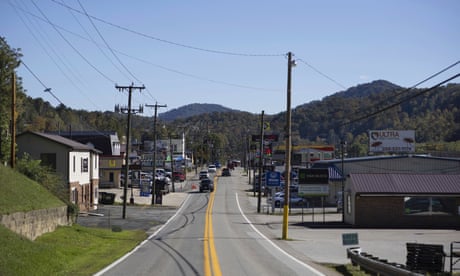Coast has already heated up by 2C over the past century, thanks in part to warming Atlantic Ocean

Oliver Milman
@olliemilman
Thu 23 Sep 2021 16.00 BST
The coastal US north-east is one of the fastest warming areas in the northern hemisphere, having heated up rapidly by 2C (3.6F) already over the past century due in part to the soaring temperature of the nearby Atlantic Ocean, new research has found.
The coastline that stretches from Maine down to Delaware hosts urban areas such as New York City and Boston and draws millions of tourists each year to beaches and other attractions. But the region is rapidly changing due to the climate crisis, having heated up by 2C on average since the start of the 20th century, driven largely by much warmer summers.
This is one of the fastest temperature increases in the northern hemisphere, researchers found, and is double the level of heating that has taken place further inland in the same region.
The world’s governments have agreed to limit the overall global temperature rise to “well below” 2C to avoid disastrous heatwaves, floods and other impacts. The US north-east has itself now, in isolation, already breached this threshold.
“It really pops out, it’s a big jump in temperature,” said Ambarish Karmalkar, a climate scientist at University of Massachusetts Amherst and lead author of the paper, published in Nature Climate Change. “It’s an exceptional level of warming and what is surprising to me is that it’s so different within a small region. The interior of the US north-east has only warmed by 1C, whereas these popular coastal areas have warmed by 2C. That’s a big difference.”
Karmalkar and his colleague Radley Horton sought to establish the reasons for this brisk temperature increase and have pointed to a link between the rising heat of the northern Atlantic Ocean and that of the nearby land.

How the US labor movement is getting to grips with the climate crisis
A large system of ocean currents, known as the Atlantic Meridional Overturning Circulation (or Amoc), acts as a sort of conveyor belt for the ocean, bringing warm, salty water from the tropics north towards Greenland, where it cools and sinks.
Recent studies indicate that this watery conveyor is slowing down as the climate heats up, meaning that warmer water is piling up along the US east coast, in places such as the Gulf of Maine and the Mid-Atlantic Bight. This warming, which is upending traditional fisheries as marine ecosystems morph, has helped drive up temperatures along the coast with the aid of altered wind patterns, according to the researchers.
“The sea surface temperatures have gone up dramatically, much faster than the global average, and more heat is being dumped there by the slowing conveyor belt,” said Karmalkar. “You are also getting these anomalous winds, and these two factors together are driving warming trends.”
Cities in the US north-east have been primarily focused on the dangers of flooding wreaked by the climate crisis – record rainfall caused severe flash flooding that killed dozens of people in New York earlier this month – but Karmalkar said that authorities would increasingly have to focus upon rising heat if current trends continue.
“The exceptional warming we’ve seen can have serious implications for heat stress and human health,” he said. “Lots of people vacation on this coast but the warming may change how people use the space. This will become an important public health issue to deal with.”
Bob Kopp, a climate scientist at Rutgers University who was not involved in the research, said the study “nicely identifies” possible causes for the heating of the US north-east. Kopp added that adaptations to this heat would have to take place.
“Of course, there are huge inequities within the United States, and within the region the harms of extreme heat will tend to be felt most heavily by lower-income people,” he said. “This is also a densely urbanized area, with a substantial urban heat island effect.”
Scientists have warned that countries are still not cutting planet-heating emissions quickly enough to avoid catastrophic consequences, with places from the US west to Germany to China already experiencing recent severe climate crisis-fueled impacts. “These changes will only become worse if humans continue to emit carbon dioxide,” said Natalie Mahowald, a climate scientist at Cornell University.
The Coastal Northeastern US is a global warming hotspot

New research, led by the University of Massachusetts Amherst reveals, for the first time, not only that the coastal Northeast—from Maine to Delaware—is heating faster than most regions of North America, but that this heating is linked to drastic alterations in the ocean and atmospheric conditions over the North Atlantic.
"What does global warming mean for the Northeast?" asks Ambarish Karmalkar, professor of geosciences and researcher at the Northeast Climate Adaptation Science Center at UMass Amherst and lead author of the paper which recently appeared in Nature Climate Change. As Karmalkar started to pursue this question, he began noticing two disconcerting phenomena: the coastal Northeast is warming faster than most other regions in the U.S., and the northwestern Atlantic Ocean is also warming at a much faster rate than all the oceans as a whole. "I wanted to know if there was a link between these two trends, and if so, what that link is."
"The key findings here are that the observed warming in coastal Northeast is exceptional," says Karmalkar, "that some of the biggest populations centers in the U.S. are suffering the greatest degree of warming, and that this warming is being driven both by equally rapid trends in the Atlantic Ocean and by changes in atmospheric circulation patterns." Additionally, Karmalkar's research shows that, not only are Northeastern winters getting warmer, as expected, but significant and rapid summer warming is happening along the coast.
Several recent studies indicate that the Atlantic Meridional Overturning Circulation (AMOC) is slowing down due to climate change. Envision AMOC as a conveyor belt that transports warm, salty water from the tropics north toward Greenland, where it cools and sinks. This cooled water then flows back south in the form of deep-water currents. But as the climate warms, and glaciers in Greenland melt, the conveyor is slowing down. "One consequence of this conveyor belt slowdown is more heating of the ocean off the Northeastern coast, which helps to explain the spike in ocean temperatures in the Mid-Atlantic Bight and Gulf of Maine regions," explains Karmalkar.
One link between AMOC and rising temperatures in Boston, New York and Providence is the North Atlantic Oscillation (NAO), a weather phenomenon that governs the strength and position of the winds that blow from the US, over the Atlantic and on to Europe. There's a degree of natural variability to the NAO, which influences everything from storm tracks, the jet stream and seasonal temperatures in the Northeast. However, as Karmalkar and his co-author Radley Horton from Columbia University show, the NAO has, for the past few decades, tended to settle into a pattern which enhances the influence of ocean air on the climate of the eastern seaboard. Because the northwestern Atlantic is also warming due to the AMOC slowdown, this means that warmer ocean air is being blown over the coastal Northeast, accelerating land-based heating trends.
Karmalkar's research also highlighted the importance of using a new generation of high-resolution climate models that could more accurately capture changes in regional climate. "Our research," says Karmalkar, "implies that without improved high-resolution data, regional climate assessments, which inform our ability to plan for the future, may underemphasize warming in this populous region."Study pinpoints key causes of ocean circulation change
More information: Drivers of exceptional coastal warming in the northeastern United States, Nature Climate Change (2021). DOI: 10.1038/s41558-021-01159-7 , www.nature.com/articles/s41558-021-01159-7
Journal information: Nature Climate Change
Provided by University of Massachusetts Amherst
No comments:
Post a Comment